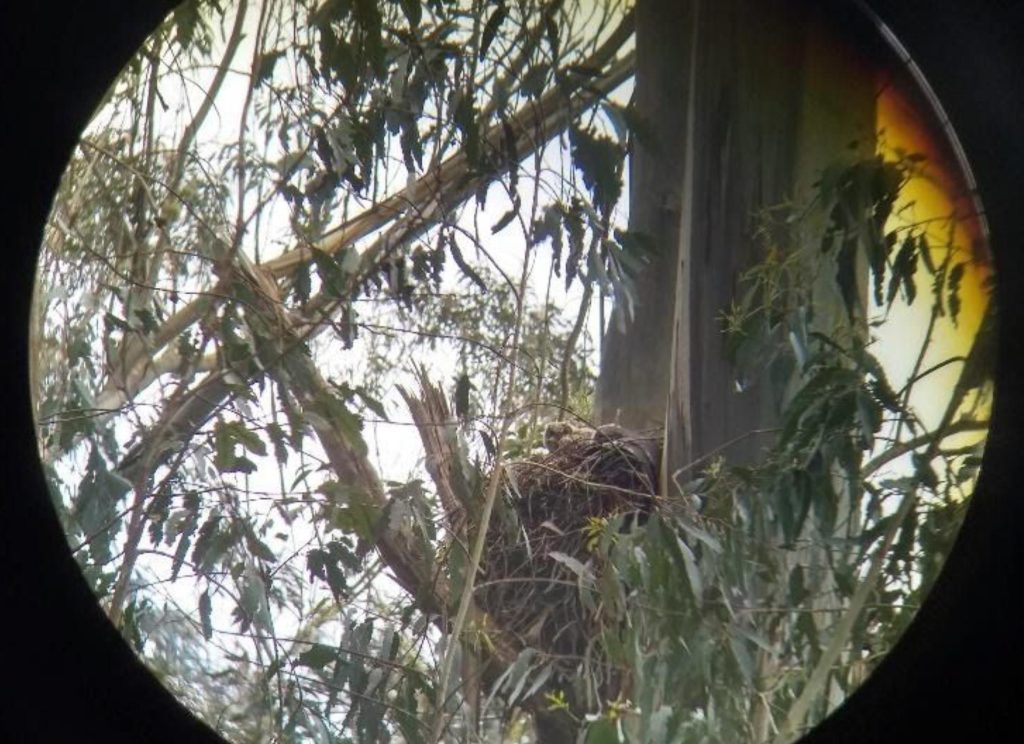Breeding Birds Update by Mel Preston of Point Blue Conservation Science
By:Mel Preston of Point Blue Conservation Science
In Pescadero (and the rest of the northern hemisphere), bird nesting season is in full swing. Earlier this spring, I was collecting data in a eucalyptus grove on TomKat Ranch when I looked up to meet the gaze of these nestling Great Horned Owls. Luckily for me, they didn’t know how to fly yet and their interest in me was unwavering, so they were quite still for a long time and I was able to take their portrait by holding up my phone camera to my binocular lens (which explains the black circle and the weird orange spot in the corner of this photo). Most of the bird nests I see go un-photographed, so it’s nice when I have a chance to share the view.
At ranch headquarters, the Barn and Cliff Swallows have been back since late February, and the eves of the barns have their usual spring-time mud homes, each with their own set of nestlings soon to be peeping out at us. As a bird biologist, one of the most common questions I get asked in springtime is “How do I stop this bird from nesting over my door/on my porch/ under the eves?” It is a question I have a lot of trouble answering because I wish I were being asked the opposite question, which would be “How do I help this bird family that is nesting by my house?”
However, regardless of whether folks like to hear it, my answer is the same for both questions: let the nest be, keep your cats (and other predators) away from it, and enjoy the show. Bird families are so much fun to watch. First, there’s the nest-building phase, when the pair is sticking close together and we get to see all their romantic interactions, plus the interesting materials they find and incorporate into their nests (chickadees with beak-fulls of husky hair is my favorite example from this year). While the male might sing mightily from a nearby perch, the female gets really quiet when she sits on the eggs- sometimes so quiet you forget the nest is there, which is kind of the point since this is a time of immense vulnerability. Once they hatch, one can observe what kind of food the parents bring- usually insects, which have lots of protein, since baby birds need to grow very strong, very fast. Since nests themselves contain a protein and fat-rich meal (the eggs or nestlings themselves), they often don’t survive because there are plenty of predators hunting for them- cats, jays, rodents, snakes, and the list goes on. Eventually, if the nest survives, the babies will fledge, and you might witness them take the first flight of their life. If the young do fledge, wish them well, because now they are trying to find food, avoid predators, survive winter storms, and often migrate thousands of miles, all before they turn one year old. Talk about over-achievers!
Birds go to immense trouble to have a family, and the sad-but-real truth is that often their babies die before they reach adulthood. If you are one of the humans lucky enough to have a bird nest near your house, consider letting it be where it wants to be, and doing your best to guard the nest (i.e. don’t let your cat or dog get to it). In my opinion, begging baby birds at 4 am and piles of bird poop on your favorite porch chair are more than a fair exchange for being lucky enough to live somewhere the birds like to be too.
